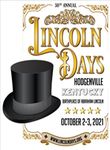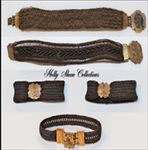October 2 - 3, 2021 - Lincoln Days Celebration - The Association of Lincoln Presenters
←
→
Page content transcription
If your browser does not render page correctly, please read the page content below
October 2 – 3, 2021 – Lincoln Days Celebration
The “Lincoln Days” Festival in Hodgenville, Kentucky will celebrate their 50th year anniversary the first
weekend of October. The Association of Lincoln Presenters has attended through the years to support
this small town’s festival that honors our greatest American president. Come and be a part of the
celebration! This year’s Lincoln Days will include a weekend full of festivities to honor Hodgenville’s
most famous native son.
Joan Howard has been working to create a special event
for the Association before the festival. On Friday morning
October 1, Mr. and Mrs. Lincoln have been invited to
present short presentations at the town’s two
elementary schools. If you are interested in participating
in the school visit, please call Joan, 502-545-1071. There
will be time in the afternoon to visit the Lincoln Museum
and the Lincoln Birthplace. Also on Friday evening we
will enjoy a a catered dinner at a restaurant on
Hodgenville’s town square. Cost for the dinner and social
hour is approximately $25.
The Lincoln Days Celebration starts Saturday morning with
a ham breakfast for all costumed interpreters. Lincoln
Days activities include the Abe and Mary Lincoln “look
alike” contests, food and craft vendors, plenty of live
music and the return of traditional activities such as the pioneer games, quilt show, art contest and
craft exhibits. Lunch is also provided to the costumed presenters and their spouses. The highlight of
the day is the parade of Lincoln presenters leading the parade and riding on floats.
The Association hasn’t been able to hold a conference the last two years. This is an opportunity to
reconnect with each other. Please put this event on your calendar and plan to attend. The city of
Hodgenville roles out the welcome mat for the ALP and they appreciate our participation and
presence.
Check out the Lincoln Days Celebration website
http://www.lincolndays.org/schedule/
Hotel – Country Inn and Suites, 107 Buffalo Creek Drive, Elizabethtown, KY 42701
270-769-1334 When making your reservation, ask for the ALP rate of $99.99 per night.Event – Mary Lincoln’s Coterie – July 16-17, 2021 Join Mary Lincoln’s Coterie in Springfield, Illinois to honor Mary Lincoln on the anniversary of her death. The following is a schedule for the event (as of June 11). From Mary Lincoln’s Coterie Facebook page. Check this page for updates and instructions for registering. The founders of the Coterie have planned a full weekend of great events which include: Friday, July 16 2-4 pm Ice Cream Social at Edwards Place, Springfield. Coterie member Pam Brown will present Mary Lincoln. (This event is hosted by Edwards Place and open to the public.) Friday, July 16, 6 pm Welcome dinner and Strawberry Party, location TBD, Hosted by the Coterie, Speakers: John and Jane McKee, Immediately following Strawberry Party (8pm), there will be a vigil for Mary Lincoln. Saturday, July 17, 10 am Memorial Service and wreath laying at the Lincoln Tomb, Speakers: Elizabeth Taylor & TBD Saturday, July 17 11 am A tour of Oak Ridge Cemetery (by car) Meet in the Lincoln Tomb parking lot and we will caravan around cemetery to some notable graves. Hosted by Valerie Gugala. Saturday, July 17, 12:30 pm Lunch at Abe’s Hideout, 2301 S Dirksen Pkwy, Springfield (everyone will be responsible for their own meal) Saturday, July 17, 7:30 pm S’mores and drinks (BYOB) at the Staybridge Suites South. Hosted by Brian and Valerie Gugala. An American Marriage The Untold Story of Abraham Lincoln and Mary Todd Michael Burlingame – June 2021 This is a new book about Mary and Abraham Lincoln’s marriage. The dust jacket describes this new work “Based on thirty years of research, An American Marriage describes and anlyzes why Lincoln had good reason to regret his marriage to Mary Todd.” The book promises to be something we need to read but not with pleasure.
Lincoln and Cats……. From Ford’s Theater Facebook Page, June 5, 2021 Post.
From a boy to adulthood, Abraham Lincoln showed love for
animals, but especially cats. Mary Lincoln often said that
cats were his hobby.
In March of 1865, he displayed this affection toward cats
while visiting General Grant at City Point (Petersburg
National Battlefield). As he passed the telegraph office, he
noticed three kittens that appeared lost and were meowing.
Lincoln picked up one of the kittens and asked it, “Where is
your mother.” Someone nearby told him their mother was
dead. Upon hearing this Lincoln petted the kitten and
responded, "Then she can't grieve as many a poor mother is
grieving for a son lost in battle." He then picked up the other
two kittens and placed them on his lap and told them,
"Kitties, thank God you are cats, and can't understand this
terrible strife that is going on." Before leaving them, he
asked a member of General Grant’s staff to feed them and,
"treat them kindly.”
Are you a cat person? Or do you have another favorite pet? #FordsTheatreNPS #AbrahamLincoln
Mary Lincoln’s Executive Mansion China
From Ford’s Theater National Historic Site.
The holiday season is a time when
gatherings often call for special table
settings and decorations. Mary Lincoln
believed that formal entertaining was
important year-round and wanted the
White House to reflect the country’s
significance and style.
When she arrived to the executive
mansion in 1861, she was disappointed
to find no complete set of formal china.
So, in one of her first official duties, she began the tradition of first ladies selecting their White House
china.
Mrs. Lincoln oversaw the creation of what would be one of the most renowned sets of presidential
china, the “Lincoln Solferino china.” The set was named for its distinguished shade of purplish-pink.The unique color was created in 1859, the same year as Napoleon’s victory at the “Battle of Solferino.”
Purple was a favorite of Mrs. Lincoln and “Solferino” had become a fashionable color throughout
Europe.
In addition to being beautiful, the Lincoln china is distinctive for its scalloped edging, patriotism, and
symbolism: the two-strand gold rope border signifies the union of the North and South.
The design retained its elegance through the years and became one of the most reordered sets at the
White House.
The administrations of Presidents Ulysses S. Grant, Chester A. Arthur, and Grover Cleveland ordered
full matching replacements. First Ladies Jacqueline Kennedy and Betty Ford used pieces of the
treasured Lincoln "Solferino" china as serving plates. A reproduction of the beloved set was also
created for the inaugural luncheon of President Barack Obama in 2009.
Why do you think so many first families have showcased the Lincoln china? How would Mary feel
about this?
Hairwork Jewelry
Throughout time a lock of hair has been an intimate
Romantic token, a special keepsake or even
commemorative of important events and deeds.
The incorporation of human hair in jewelry seems,
to have begun sometime during the Middle Ages and
continued to increase in popularity through the years.
Hairwork art and jewelry reached its zenith during the
Victorian era, thanks to Queen Victoria favoring the fashion.
It is known that when her husband, Prince Albert
passed away, the queen wore a heart-shaped locket containing the prince’s hair over her heart. She
also wore a bracelet with nine heart-shaped lockets, each of which contained a lock of hair from her
children. She also gave a bracelet made of her own hair to Empress Eugenia of France. Hair generally
doesn’t decay so these mementos were seen as lasting sentimental tokens.
An amazing array of jewelry was made from hair
including brooches, bracelets, earrings, necklaces,
rings, chains, watch fobs, cravat and shawl pins,
etc. Initially this jewelry seems to have been
produced primarily by professionals. However, it
eventually was viewed as a proper pastime for
Victorian ladies and publications such as Godey’s
Lady’s Book and Peterson’s Magazine
offered “how to” instructions as early as the 1850s.
This is a hair brooch that was made from Susan Miller’s hair. It swivels around and displays her picture.Balmoral Petticoat …. Source: Dreamstress.com
Both images are black and white litho
with the only color being the exposed
Balmoral.
The one on the left depicts an elegant
woman lifting her skirt to expose her
Balmoral petticoat.
The one on the right advertises Bruner's
Balmoral petticoat of Philadelphia and
depicts a courting couple.
The Balmoral petticoat was a colored petticoat that was intended to show at the hem of a drawn-up
skirt for walking and sportswear in the 1860s and 1870s.
The Balmoral petticoat could be worn over a hoopskirt or
crinoline or have hoops built into the petticoat, and
(according to some sources) include a horsehair stiffener
as part of the petticoat itself. The most common Balmoral
petticoat was red wool, often with 2-4 black stripes
running around the hem. Later in the 1860s there are
mentions of Balmoral petticoats in plaid or striped wool,
and even cotton Balmoral petticoats in the Americas.
The Balmoral petticoat was most popular at the height of the
crinoline era, but quickly became a victim of its own popularity
and practicality. Fashion has never loved sensible garments,
and Balmoral petticoats were eminently sensible: warm,
durable, easy to walk and move in. They were adopted by all
levels of society almost immediately (there are numerous
mentions of slaves in the American South wearing Balmoral
petticoats in the 1860s), and quickly discarded by the upper
levels of society.
A variant of the Balmoral petticoat (sans hooping) remained popular with older women and the less
fashionable for decades after the crinoline was discarded. As a result the red flannel petticoat became
synonymous with provincial fashion and the elderly. This image above is of a fashionable woman from
France wearing a Balmoral petticoat, and Zouave jacket.Chatelaine Before handbags were the ultimate accessory to carry things, in an elegant way; there was this curious artifact that fell into oblivion with time. Designed very similar to a tool belt, it was the ′′ Chatelaine.′′ A sewing chatelaine A sewing chatelaine Miser’s Purse Gwen Blakley Kinsler – 2017 Pieceworks The Miser’s purse originated late in the eighteenth century and was variously called misers, hookers, almoners, wallets, or long stocking. The shape of the miser’s purse originated from the medieval practice of carrying coins in the toe of a stocking. A large version—as much as a couple of feet long and perhaps used largely by men during the eighteenth century—gradually became smaller and more refined. The miser’s purse grew in popularity on the continent and in England during the nineteenth century. During the second half of the century, it became one of the most common purses that Victorians carried. Used by both women and men, the typical nineteenth-century miser’s purse was a long tube made of “purse” or “netting” silk, often crocheted, netted, or knitted, with or without beads. Narrow in the middle and closed at both ends, during the Victorian era, many miser’s purses were 8 to 10 inches long. The “toes” of the purse, which might be of the same or different shapes, often were tasseled or fringed. A short slit in the narrow midsection of fabric let the carrier drop coins or other small objects into either end of the tube. It could be closed off by moving two rings, or sliders, of different materials including steel, brass, silver, gold, or mother-of- pearl toward the ends, gathering the fabric snugly around the contents. From its first issue in July 1830 until its demise in 1879, Godey’s Lady’s Book contained patterns and directions for making purses of all sorts. An openwork crochet miser’s purse was featured in the September 1862 issue.
You can also read



























































